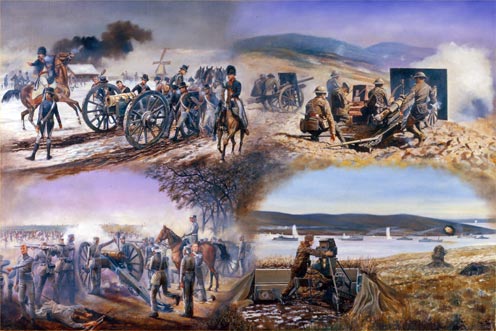| |
« Click on Picture to
Return » |
|
|
 |
|
12 Regiment Royal Artillery
1794. Capt Winter’s Company, 1st Battalion RA, Netherlands.
Later 12 (Minden) Air Defence Battery RA.
1857. 1st Company, 5th Battalion, Bengal Artillery at the action of Bibigunge, during the Relief of Arrah.
Later 58 (Eyre’s) Air Defence Battery RA.
1918. 2nd Mountain Battery RA, Macedonia.
Later 9 (Plassey) Air Defence Battery RA.
1982. T Air Defence Battery RA, Falklands War.
1794. Capt Winter’s Company, 1st Battalion RA, Netherlands.
Later 12 (Minden) Air Defence Battery RA. (Formed in 1747 as Captain J. Goodyer’s Company).
This company landed at Dordrecht in 1793 and served the field guns attached to the Guards Brigade. It was engaged in several battles and sieges in Flanders and Holland against the French Revolutionary army. During the winter of 1794-95 the British Army suffered almost unprecedented hardships in an inhospitable country during the coldest weather there had been for many years. Here a 5 ½ inch howitzer is being brought into action.
1857. 1st Company, 5th Battalion Bengal Artillery at the action of Bibigunge, 2nd August 1857. (Formed in 1756 as part of the East India Company’s forces. Later 58 (Eyre's) Air Defence Battery RA).
When the native troops of the Bengal Army mutinied in 1857, they besieged the little garrison at Arrah. Major Vincent Eyre with the men and guns of No. 3 Field Battery, 1/5 Bengal Artillery was passing by river en route to Allahabad. He was ordered to leave some guns at Dinapore, and with two 9-pounder guns and a 9-pounder howitzer, and a detachment of the 5th (Northumberland) Fusiliers, he marched eastwards, and on the morning of 2nd August confronted the rebels at Bibigunge. Flanked by the railway embankment on the right, the small British force had an hour’s hard fighting; the rebels made two determined attempts to rush the guns, but rapid fire of case shot and shrapnel caused them to flee, and led to the relief of Arrah.
1918, September. 2nd Mountain Battery, Royal Garrison Artillery, Macedonia.
Later 9 (Plassey) Air Defence Battery RA. (Formed in 1748 as the first company of Bengal Artillery, in the East India Company’s forces).
During the 1st World War, the battery initially served in France, but moved to Salonika in December 1915 as part of 3rd Mountain Brigade, Royal Garrison Artillery. Armed with 2.75 inch mountain guns, it fought against the Bulgarians (Germany’s allies) at Doiran and the Struma River in 1918 in a harsh landscape with a climate of very cold winters and hot summers. The equipment could break down into six mule loads, to enable transportation over difficult terrain.
1982, May. T Air Defence Battery (Shah Sujah’s Troop) Royal Artillery in the Falklands Islands.
(Formed in India in 1838 as Shah Sujah’s Horse Artillery).
The British forces landed in the Falklands, which were occupied by Argentinian troops, on 21st May. Rapier fire units were established on both sides of San Carlos Water where the British ships came under repeated attacks by enemy aircraft. By the third day of the landing many fire units had established small redoubts constructed of empty missile containers. The No.1 aimed the head of the optical tracker in the direction of the approaching aircraft, which usually attacked at very low altitude, often no higher than the ships’ masts. During the campaign T Battery’s fire units destroyed at least fourteen Mirages and Skyhawks; the ground forces suffered only slight damage from a brave and skilful enemy.
Commissioned by the WOs and Sergeants Mess, 12 Air Defence Regt RA
Medium: Oil on Canvas
Printed image size(s): B2 only (58 x 38 cm)
Owner: 12 Regiment Royal Artillery
Price(s): £70
|
|
| |
|
|
|
|
|
|
|
|
|
|
|
|
|
|
|
|











